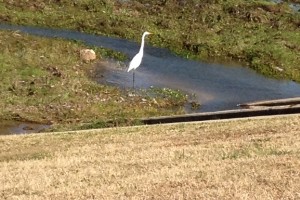Have you ever noticed a sole egret standing by a stream? Or just one blue heron alone on a riverbank? What happened to birds of a feather, what happened to the flock? (What’s wrong with this bird?)
Nothing it turns out. Many birds – like people – are living alone. Not all birds hang in groups all the time, according to Richard Gibbons, Director of Conservation for Houston Audubon. “There are plenty of solitary birds,” he said. (Yes, how well we know!)
Dining Alone
Some of birds’ alone/together behavior depends on food sources. Gibbons told me that my solitary egret was probably staking out his or her food territory. An egret may stand alone for hours, not even moving. And when some good food comes along, he/she dines. (These birds eat alone and don’t seem to miss chattering.)
Gibbons explained some of their alone time has to do with whether their food sources are clumped or dispersed. If there’s lots of food in one place, lots of birds may go there to feed. If food is scarce or not close together, birds won’t be either.
Central Park in summer
For birds, life is not just about food. For most birds, travel plays a key role. According to Delta Willis of the National Audubon Society in New York, birds are on the move a lot, traveling from north to south and south to north – migrating. In the winter, maybe 200 species of birds live in Central Park, she said, in the spring about 275 species live there. (People migrate, too, in the winter thousands of Northerners – known affectionately as “snow birds” – head south to warmer climes.)
Slighting birds
It seems birds lead more interesting lives than I thought, what with migratory patterns, dining habits, not to mention nesting preferences (cavities or branch, for example). I was beginning to think I was not doing the topic of solitary bird behavior justice, so I checked with Geoff LeBaron, director of the Christmas Bird Count for National Audubon (an initiative in which 60,000 to 70,000 people count birds). He confirmed that not all birds flock all the time. He mentioned a relative of egrets and herons, the bittern, saying it is a more solitary bird by nature and lives much of its life alone. (Before you make some connection with its name to an emotional state, Wise Geek reveals the name bittern “comes from the Old French butor, which is believed to have been derived from the Latin butionem, for “bittern” and taurus for “bull.” Allegedly, the birds were given this Latin name because of their characteristic loud cries.” (So, nothing to do with bitterness, just able to speak up when need be.)
This brief research revealed, much to my surprise, that not only each species of bird, but each individual bird leads a varied life full of adventure and activity, what with travel, hunting for the right foods, dining, building a good nest and all the work those things entail.
So the conclusion is – my sole egret is not a misfit, and living alone does not mean it’s leading a dull life. I just caught him/her quietly – and wisely – preparing for dinner.
Story and egret photos by Bojinka Bishop, except where noted. Photo of Richard Gibbons courtesy of Richard Gibbons.
For a beginners guide to bird watching, check out this great resource https://hobbyhelp.com/bird-watching/?msID=c364a370-effb-4378-8eb1-7dfe
See Comments. Click here. Share your ideas and comments. Click here.
Related stories:
- Walking Presque IsleSitting just off the shore in Lake Erie, Presque Isle State Park has miles of sandy beach on the north side, with beach grasses, trees, and gentle waves lapping. A great place to walk, especially off season....
- Can a place change your life?For Julie Riedmiller, a solo from Denver, and a seasoned traveler, the answer is “yes.” Going to Machu Picchu and trekking the mountains of Peru inspired her to create a new life plan – study Spanish, become fluent, and return to South America for a year....
- What’s next?Flying High Solo is changing, at least for a while. I launched this site as a magazine, to report on things relevant to solos – interesting people, places, and things to know and do. I didn’t intend to write about what was happening in my life. That was then…...
- DePaulo highlights 2012 media on singles/solosBella DePaulo showcases recent media coverage of the growing phenomenon of solo- and single-hood in her most recent blog....
- 5th LegOn the 5th leg of a many-legged journey: from Ohio to Michigan to New York State to Virginia to North Carolina to Texas: from the cold blustery north to the tropical palm-treed south. ...
FlyingHighSolo.com
Celebrating special people, good ideas, and useful actionsSubscribe
Keep on top of what's new – subscribe to Flying High Solo! You'll get a brief email alerting you to new articles. (Your email is safe -- we will not share it with anyone).
What readers are saying
"amazing variety of topics"
"an intelligent, strong, creative, eclectic approach .... that we don't get a chance to read everyday"
"very cool and intelligent"
Highly Recommended
 Bella DePaulo's blog for Psychology Today, "the truth about singlism..." News, analysis, facts, and stories about being single in America
Bella DePaulo's blog for Psychology Today, "the truth about singlism..." News, analysis, facts, and stories about being single in America









